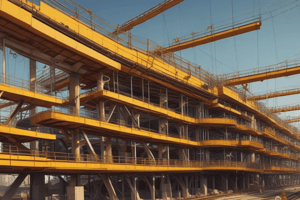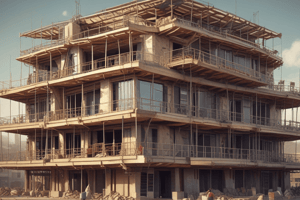Podcast
Questions and Answers
What are the two types of dynamic loads mentioned?
What are the two types of dynamic loads mentioned?
- Pressure and Suction
- Foundation Settlement and Wind
- Wind and Earthquakes (correct)
- Temperature and Moisture
How does wind affect a building during high wind intensities?
How does wind affect a building during high wind intensities?
- It causes horizontal movement of the building. (correct)
- It creates static pressure on all walls.
- It only affects the top parts of the building.
- It has no effect on low buildings.
What primarily happens to a building during an earthquake?
What primarily happens to a building during an earthquake?
- The upper part remains stationary while the foundation moves. (correct)
- All buildings collapse instantly.
- The building experiences equal vertical and horizontal forces.
- The foundation is completely unaffected.
Which component of an earthquake's motion is considered relatively harmless?
Which component of an earthquake's motion is considered relatively harmless?
What are equivalent loads primarily caused by?
What are equivalent loads primarily caused by?
What is the effect of wind on a flat roof of a building?
What is the effect of wind on a flat roof of a building?
Which material is generally not affected by changes in humidity?
Which material is generally not affected by changes in humidity?
Why are wind loads particularly crucial for tall buildings?
Why are wind loads particularly crucial for tall buildings?
What defines a Dead Load in a building?
What defines a Dead Load in a building?
Which statement is true about Live Loads?
Which statement is true about Live Loads?
What is a significant challenge in estimating Live Loads?
What is a significant challenge in estimating Live Loads?
How do building codes assist in determining Live Loads?
How do building codes assist in determining Live Loads?
In what scenario might Live Loads on a building increase significantly?
In what scenario might Live Loads on a building increase significantly?
Which type of load may be defined as stationery?
Which type of load may be defined as stationery?
Which factor complicates the assessment of Live Loads in certain buildings?
Which factor complicates the assessment of Live Loads in certain buildings?
What are some examples of spaces where specific Live Loads are defined?
What are some examples of spaces where specific Live Loads are defined?
What is the primary purpose of providing expansion joints in long walls and floors?
What is the primary purpose of providing expansion joints in long walls and floors?
What type of loads act vertically on a structure?
What type of loads act vertically on a structure?
How can uneven settlement of foundations affect a building?
How can uneven settlement of foundations affect a building?
Which solution is NOT a method for providing lateral stability in a structure?
Which solution is NOT a method for providing lateral stability in a structure?
What is referred to as the path that a load takes through structural members to the ground?
What is referred to as the path that a load takes through structural members to the ground?
Which type of load is resolved into horizontal and vertical components for analysis?
Which type of load is resolved into horizontal and vertical components for analysis?
What phenomenon can cause bricks and concrete to crack over time?
What phenomenon can cause bricks and concrete to crack over time?
What is the effect of forces on materials primarily governed by?
What is the effect of forces on materials primarily governed by?
What defines elastic deformation in a material?
What defines elastic deformation in a material?
How is stress calculated in a material?
How is stress calculated in a material?
Which of the following correctly describes strain?
Which of the following correctly describes strain?
What does Hooke's Law state about the relationship between stress and strain?
What does Hooke's Law state about the relationship between stress and strain?
What occurs when the capacity for elastic deformation is exceeded?
What occurs when the capacity for elastic deformation is exceeded?
Which materials are typically categorized as brittle?
Which materials are typically categorized as brittle?
What is a key characteristic of ductile materials when subjected to stress?
What is a key characteristic of ductile materials when subjected to stress?
Which statement is false regarding Young’s Modulus?
Which statement is false regarding Young’s Modulus?
What characterizes ductile materials compared to brittle materials?
What characterizes ductile materials compared to brittle materials?
What is the Elastic Limit in a material's behavior?
What is the Elastic Limit in a material's behavior?
What is the main cause of buckling failure in vertical members?
What is the main cause of buckling failure in vertical members?
How does increasing carbon content in steel affect its properties?
How does increasing carbon content in steel affect its properties?
Which property is particularly true for brittle materials regarding tensile and compressive strength?
Which property is particularly true for brittle materials regarding tensile and compressive strength?
What occurs at the Yield Point of a material?
What occurs at the Yield Point of a material?
What factor contributes to the likelihood of bending in members?
What factor contributes to the likelihood of bending in members?
Which of the following statements about material failure is true?
Which of the following statements about material failure is true?
Flashcards are hidden until you start studying
Study Notes
Loads Acting on a Building
- Loads are categorized into Static and Dynamic.
- Static loads are further categorized as Dead Loads and Live Loads.
- Dead Loads are stationary and include the weight of the building structure itself.
- Live Loads are dynamic and include occupants, furniture, and equipment.
- Building codes dictate the loads to be considered for different types of occupancies.
- This information comes from surveys of representative buildings to determine typical weight of furnishings and people.
Dynamic Loads
- Wind loads are a significant factor for buildings of all sizes.
- They include both pressure and suction.
- Wind pressure acts on the windward side of the building and suction occurs on the other sides and roof.
- Wind loads are particularly important for tall buildings due to their cantilever effect.
- Wind velocity is not constant, resulting in dynamic effects that need to be accounted for.
- Earthquakes are another type of dynamic load.
- They are sudden, jerky movements of the ground.
- The horizontal component of an earthquake can be particularly damaging.
- Local building codes define the anticipated earthquake intensity.
Equivalent Loads
- Result from temperature changes, moisture content fluctuations, and foundation settlement.
- Expansion joints are used to accommodate changes in size due to temperature and moisture.
- Uneven foundation settlement can induce stress in a building's superstructure.
Transmission of Loads
- Loads transfer vertically and horizontally towards the ground.
- The pathway of a load through structural members is known as the load path.
- Vertical load paths are handled through compression, tension, or bending.
- Horizontal load paths require lateral stability.
- There are three methods for providing lateral stability:
- Triangulation
- Shear panels or walls
- Rigid frames
Effect of Forces on Materials
- Solid materials are held together by atomic bonds.
- These bonds can be extended or compressed, resulting in Elastic Deformation.
- As long as the bonds are not broken, the material recovers its original shape after force is removed.
- Stress is the force exerted on a material - calculated by dividing total force by the carrying area.
- Strain is the deformation of a material due to stress, expressed as a ratio of deformation to original dimension.
- The relationship between stress and strain is defined by Hooke's Law.
- The Young's Modulus of Elasticity is a constant for different materials.
Failure of Materials
- Beyond the Elastic Limit, atomic bonds start to break.
- This results in either Plastic/Ductile failure or Brittle failure.
- Ductile materials deform permanently before failure, allowing for some warning time.
- Brittle materials fail suddenly with little deformation.
- Buckling failure affects vertical members like columns and is caused by high compressive stress.
- Buckling leads to sideways bending due to compression.
- The bending causes further offset, increasing the bending moment until failure.
- Longer and thinner members tend to buckle easier than shorter and thicker members.
Studying That Suits You
Use AI to generate personalized quizzes and flashcards to suit your learning preferences.





